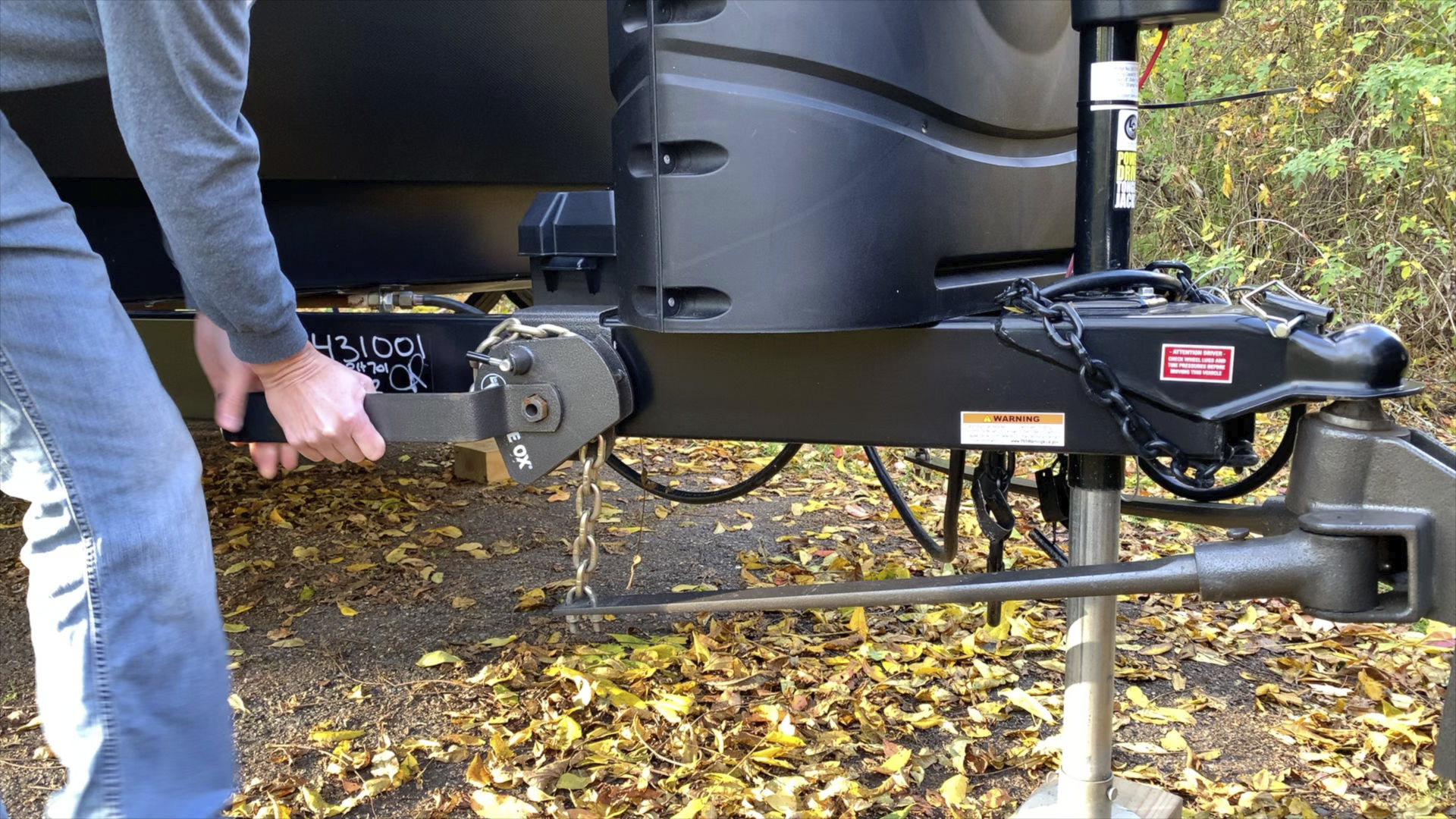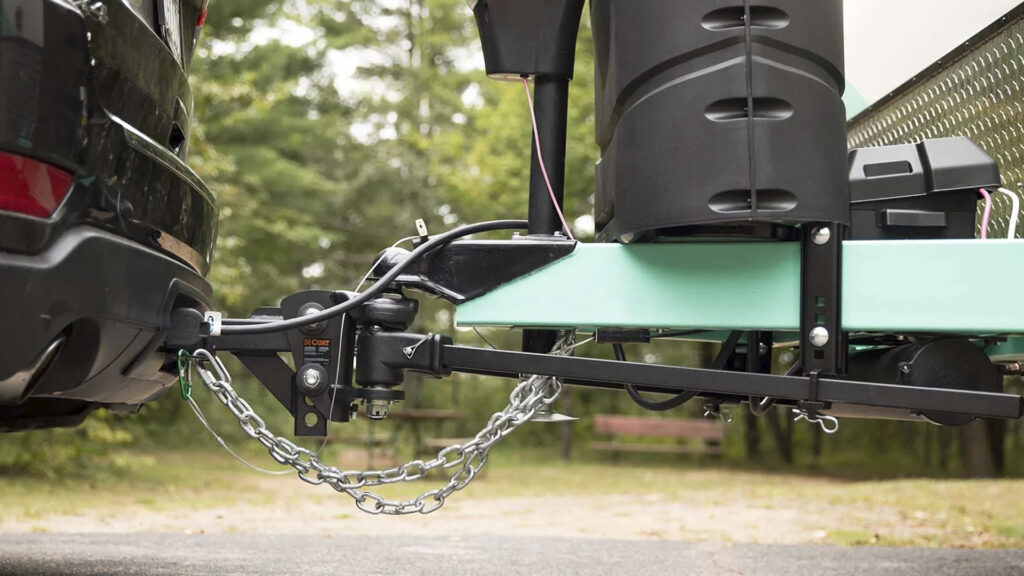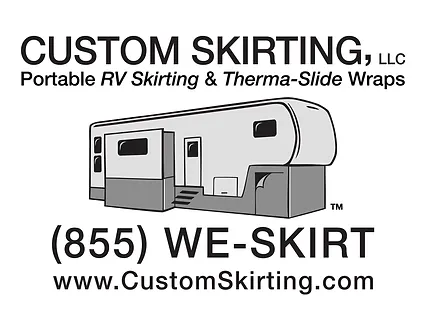
Do I Need a Weight Distribution Hitch? Guide for RV Owners
Table of contents
- Understanding Weight Distribution Hitches
- Signs You May Need a Weight Distribution Hitch
- Determining the Right Weight Distribution Hitch for Your Setup
- Installation and Setup Considerations
- Do You Need a Weight Distribution Hitch? Making the Decision
- Maximize Your RV’s Comfort and Protection with Custom Skirting
- Related Articles
Towing an RV or trailer can be a rewarding experience, offering freedom and flexibility on the open road, but it’s also a big responsibility. Ensuring safe towing requires careful weight management since improper weight distribution can lead to significant performance issues and safety risks, including trailer sway, uneven braking, and reduced steering control. A weight distribution hitch (WDH) can help alleviate these issues, especially for larger trailers or when taking on long journeys. Many RV owners ask questions like, “Do I need a weight distribution hitch?” or “Is a weight distribution hitch necessary?” Understanding these hitches is essential not only for safety but also for enhancing the towing experience by providing improved stability and control. In this guide, we’ll dive into what weight distribution hitches (WDHs) do, common signs indicating their need, the key benefits they bring to both safety and performance, and how to choose the best weight distribution hitch for your setup, ensuring smooth, stress-free travels.
Understanding Weight Distribution Hitches
A weight distribution hitch is a towing accessory designed to distribute the trailer’s weight evenly across all axles of both the tow vehicle and trailer, ensuring stability and safety when towing heavy loads. Typically, without a WDH, the trailer’s weight rests heavily on the rear axle of the tow vehicle, which can cause an uneven load distribution. This imbalance can lead to issues such as poor steering control, reduced braking ability, and increased sway, which makes driving riskier and more challenging, especially on highways or in windy conditions.
The hitch works by transferring a portion of the weight from the rear axle to the front axle of the tow vehicle and the trailer’s axles, achieving a more balanced load. This balance not only enhances steering control and braking performance but also helps maintain a level towing stance, preventing the rear of the vehicle from sagging. As a result, the tow vehicle and trailer are both less strained, fuel efficiency can improve, and the entire towing experience becomes smoother and safer.
Components of a Weight Distribution Hitch
A weight distribution hitch includes several key components that work together to provide the right balance and stability:
- Spring Bars: These bars transfer weight from the rear axle of the tow vehicle to the front axle and trailer axles. They come in two styles: round bars and trunnion bars.
- Hitch Head: The central piece where the trailer tongue connects, the hitch head is the control point where the spring bars attach to ensure weight distribution.
- Chain Assemblies or L-Brackets: These attachments secure the spring bars to the trailer frame, transferring weight and stabilizing the entire towing system.
With these parts working together, a WDH significantly improves stability, especially when dealing with heavy trailers or uneven roads.
Signs You May Need a Weight Distribution Hitch

Wondering, “When do I need a weight distribution hitch?” Several signs indicate when it might be time to consider one. Here are some common indicators.
Trailer Weight vs. Tow Vehicle Weight
When the trailer’s loaded weight exceeds 50% of the tow vehicle’s weight, a WDH is highly recommended. A heavier trailer can overload the rear axle, leading to poor steering control and excessive strain on the vehicle. A properly selected weight distribution hitch can evenly spread the load, enhancing safety and ride comfort.
Vehicle Handling Issues
Experiencing handling problems, such as steering instability, swaying, or braking difficulties, often indicates a need for a weight distribution hitch. When a trailer’s weight rests too heavily on the rear axle, it can compromise the vehicle’s stability and control. A WDH helps distribute weight and reduces sway, offering improved handling for a smoother and safer towing experience.
Manufacturer Recommendations
Always check your vehicle and trailer manufacturer’s guidelines for towing. Many manufacturers specify whether a WDH is needed for certain weights or load conditions. Ignoring these recommendations may lead to unsafe towing conditions and can even void warranty coverage on your vehicle or trailer.
Determining the Right Weight Distribution Hitch for Your Setup
Selecting the best weight distribution hitch requires understanding factors like tongue weight, weight ratings, and hitch types.
Understanding Tongue Weight
Tongue weight is the downward force the trailer exerts on the tow vehicle’s hitch. Proper tongue weight typically falls within 10-15% of the trailer’s total weight. Maintaining this range prevents handling issues and promotes safe towing. Tongue weight can be measured with a specialized scale or at some truck stops.
Weight Ratings and Capacity
WDH come with specific weight ratings. To ensure safety and effectiveness, match the hitch’s capacity with the trailer’s total weight. For example, a trailer weighing 8,000 pounds may need a hitch with an 800-pound tongue weight capacity. Choosing a hitch with the appropriate weight ratings avoids overloading the hitch and ensures the safety and performance of the system.
Types of Weight Distribution Hitches
There are various types of WDH systems to choose from, each with unique benefits:
- Round Bar: Common in WDH setups, round bars provide easy adjustment and generally lower cost. However, they offer less ground clearance.
- Trunnion Bar: These hitches provide more ground clearance and stability. They are slightly more complex and usually cost a bit more but can offer better performance.
- Chain-style vs. L-bracket: Chain-style hitches allow for easier height adjustments, while L-brackets provide better stability and are often preferred for heavier trailers.
Installation and Setup Considerations

Professional vs. DIY Installation
Weight distribution hitches require precise setup for maximum effectiveness, and improper installation can compromise safety. Professional installation ensures proper alignment and tension. DIY installation is possible but requires careful attention to detail. For first-timers, professional setup may be the safer choice.
Adjusting Your Weight Distribution Hitch
After installation, periodic adjustments are necessary to accommodate different loads or driving conditions. Some common adjustments include:
- Spring Bar Tension: This controls how much weight is distributed. Adjustments may be necessary based on the load.
- Hitch Height: Adjusting the hitch head height helps align the trailer with the tow vehicle for smooth towing.
Regular checks are essential to ensure optimal performance and safety, especially after loading or when encountering different road conditions.
Do You Need a Weight Distribution Hitch? Making the Decision
For many RV owners, understanding the answer to “do I need a weight distribution hitch?” depends on various factors, including trailer weight, handling issues, and manufacturer recommendations. If you are unsure, consider consulting a towing expert or referring to your trailer’s manual to ensure you have the proper setup for a safe and stable ride.
Whether you’re an experienced RV owner or a first-time trailer owner, a weight distribution hitch can greatly enhance your towing experience by improving stability, control, and safety. By choosing the right hitch for your setup and ensuring proper installation, you’ll enjoy peace of mind on every journey.
Maximize Your RV’s Comfort and Protection with Custom Skirting
Ready to improve your RV’s comfort and efficiency? Along with finding the best weight distribution hitch for smooth towing, Custom Skirting is essential for maintaining a cozy, draft-free living space. Our expertly designed RV skirting not only blocks out cold drafts but also prevents crucial components, like plumbing, from freezing—keeping your family safe and comfortable all season long. With our “No-Snap, No-Gap” channel system, we provide a custom fit to shield against harsh elements, making it perfect for RVers who want worry-free protection in every adventure. Book Custom Skirting today, and give your RV the reliable insulation it deserves!
